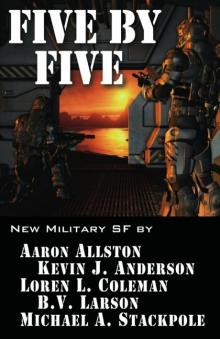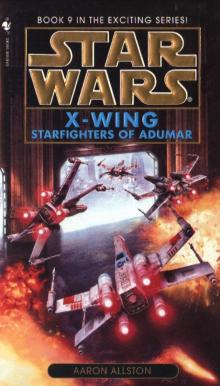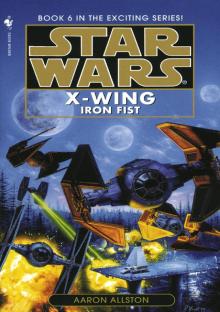- Home
- Aaron Allston
Starfighters of Adumar Page 3
Starfighters of Adumar Read online
Page 3
“Next time they can send holos.”
Wedge grinned and began the descent into the atmosphere. He brought his shields up and kept his speed fairly high. This would give the population below something to see: The friction of the atmosphere on the shields would make the X-wings look briefly like meteors shooting out of the skies. It would also give him a chance to learn more about their escorts.
The escorts ten klicks below him entered the atmosphere first—and slowed their forward speed to do so. Wedge nodded. That suggested, though it did not prove, that the escorts weren’t able to handle atmospheric reentry as well as an X-wing with shielding. Above him, the high-guard escorts also slowed as they reached the barrier of the atmosphere. Soon Red Flight was far out ahead of the chase vehicles.
They descended toward Adumar’s surface, soon recognizing cities with skyscrapers, cultivated fields, untouched forests, broad lakes and rivers. It was, unlike Coruscant, a pretty world.
Sensors showed more vehicles rising in their path at intervals of fifty and a hundred kilometers, but these vehicles stayed to either side of Red Flight’s course, not pursuing as the X-wings passed. “A gauntlet,” said Red Four.
“Maybe if they were firing,” Wedge said. “Here, they’re more like distance markers.”
“They could keep track of us on sensors,” said Red Three, “and scramble a flight if we veered off our assigned course. I’d like to know what they’re doing. Show of force?”
Wedge shook his head. If this had been a show of force, they would have had a much larger unit of vehicles in the air, and would have been making much closer passes. But Wedge didn’t have the answer, either. “Less chatter, Red Flight.”
One blip rising into their path did so at a halfway point between the “distance marker” vehicles, and its range to Red Flight closed much faster than the rest. It had to be heading toward the X-wings rather than attempting to pace them. As Wedge watched, the sensor board identified the blip as a group of four fighters flying in tight formation. Their course showed them heading straight toward the X-wings. “Heads up, Red Flight,” Wedge said. “This may be trouble.”
His comm unit came alive with transmissions, disjointed phrases crowding one another out. “Rad Flat, tha flightknife approaching your position… Buan ke Shia challenges Waj Antilles! Answer!… Rad Flat autorized to defend… Dyans ke Vasan challenges Was Jansan! Answer!”
“Scramble Red Flight frequency,” Wedge said, and suited actions to words by activating his comm unit scrambler. Now people other than Red Flight listening in on the flight frequency would hear nothing but computer-mangled transmissions. “S-foils to attack position,” he continued. “Two, you’re with me. Three and Four, you’re wingmen.” On the sensor board, four more of the distance-marker aircraft were now breaking from their original courses and looping back toward Red Flight.
“Leader, Three. We can outrun them.”
“No, Three. If this culture really is as pilot-happy as we were told, taking the most sensible course out of here might cost me credibility I need. This could just be a test of nerve.”
“Leader, Four. My nerves are already tested. Can I go home?”
“Quiet down, Four.” Wedge watched the range meter’s numbers roll down. At two kilometers, the approaching fighters would be barely within accurate targeting range… but they were closing so fast that by the time the Red Flight pilots could squeeze the triggers, the computer targeting might have good locks on them. The sensor board was already uttering faint musical tones to indicate that the enemy was attempting targeting locks on them.
At three klicks, Wedge said, “Break by pairs—”
And the enemy fired. Wedge saw eight flares, two from each oncoming fighter, as the enemy launched missiles.
Wedge whipped to starboard and then instantly began to bring himself back in line with his enemies again. The maneuver yanked him out of his approach vector… but missiles accelerated so fast, and the enemy was firing so close, that his sideslip stood an even chance of forcing an overshoot by the missiles. He saw twin burn trails flash back along his port side and knew he was right.
A split second later, his targeting brackets crossed over one of the oncoming aircraft and flickered from yellow to green. Wedge squeezed his yoke trigger and saw his lasers, red pulses, leap out toward the oncoming aircraft—
He had a glimpse of the enemy, black fighter-craft, and then he was past them. Sensors registered an explosion behind him and three targets beyond that, headed away but beginning tight turns back in his direction.
He looped around to port, noted that Tycho was still on his rear starboard quarter. “Leader to Flight. Status?”
“Leader, Two. One vaped, two laser-damaged but apparently still flyable. I have no damage.”
“Three, unhurt.”
“Four, no damage yet.”
Wedge didn’t bother to issue further orders. His pilots knew what they were about. He and Tycho tightened their loop, an effort to come up behind the surviving pair of enemy fighters, while Hobbie and Janson split wide—if the solo enemy turned against one of them for a head-to-head run, the other would have a good shot at a side or rear quarter.
As he came in toward the rear of the enemy wing pair, Wedge got a good look at them. They were large for single-pilot fighters. They were longer than an X-wing by almost half, their bows ending in sharp points. Behind the cockpit, their fuselages split into odd dual-tail assemblies joined by horizontal bars at the rear. The wings, which crossed the fuselage just behind the cockpit, were broad where they joined the fighter-craft but narrowed like a vibroblade to a sharp point at the tips. The craft surfaces were a glossy black.
Wedge switched to the general comm frequency. “Red Flight to enemy fighters. Indicate your surrender now by descending to the planet’s surface.”
“No!” The enemy pilot’s voice was strained, a little high in pitch. “I will have Waj Antilles or die!”
Both enemy craft attempted a hard roll to starboard and down. Wedge and Tycho stayed with them, closing to optimum firing range—two hundred fifty meters. “You’re within our sights and not going anywhere,” Wedge said. “This is your last chance—”
The two craft rapidly decelerated, an attempt to force the X-wings to overshoot. Wedge fired and saw his quad-linked lasers shred the black craft ahead of him, punching through the fuselage directly behind the cockpit; the craft rolled in the air, its structural integrity compromised, and disintegrated into a dozen different pieces.
Tycho’s shot was more surgical. It blew through the cockpit just where the canopy met the fuselage at the rear. The fighter-craft, still intact, rolled lazily to port and began an uncontrolled plummet.
Wedge checked his sensor board. Hobbie and Janson were headed back to rejoin them.
And the other, more distant fighters, those that had turned back toward the altercation, were once again resuming their original courses, setting up the kilometers-wide corridor for Red Flight’s travel.
Wedge brought his group slowly back around on course and watched Tycho’s target until that fighter crashed onto a forested hilltop far below. A fireball bloomed out of the wreckage and began consuming it and the foliage around. “Red Flight to Adumar Central Control, what was that all about?”
“Rad Flat, Rad Flat, this is Cartann Bladedrome. Congratulations on four stops. Ar apologies far the inconvenience. Please resume the original course.”
He switched to Red Flight’s scrambled frequency. “Any of you getting any of that?”
“Leader, Three. It’s Basic, but I don’t want to imagine how they have to twist their faces to pronounce it. They don’t sound as though this was part of the planned celebrations.”
“That’s my read also, Three. Let’s resume our planned course. But keep your eyes open and your sensors optimal.”
Moments later it was before them, the biggest city they’d seen so far, a broad stretch of skyscrapers; even the smallest of buildings, at the city’s periphery, seemed t
o be six or seven stories in height. The sky above it was alive with small craft. Wedge’s navigation computer indicated that their destination was within the city borders.
As they got closer, they could see that the city was a riot of colors, each building painted differently from the ones next to it, most of them bearing one color for walls and another for roofs and trim such as ledges and window frames. Rust, brown, red, black, and tan seemed to be preeminent.
And then there were the balconies. Every building seemed to have a broad balcony. On most of the worlds Wedge visited, a balcony might extend as far as the edge of the sidewalk, but some of these stretched out over the street, almost meeting balconies from the buildings across the way.
Cables also stretched between buildings, masses of them, but whether they carried power or communications signals, or did nothing more than add structural support or please some aesthetic sense, Wedge couldn’t guess.
Red Flight’s course dictated an altitude and direction that sent the four X-wings straight down the middle of one of the city’s broader avenues, just above the rooftops. Wedge reduced speed for better maneuvering close to structures. As they entered the city Wedge could see people on the streets and especially on the balconies: fair-skinned humans dressed in flowing garments he could only glimpse as they flashed past. The people all seemed to be waving, pointing up at the X-wings. There were vehicles on and above the streets, long, broad transports without seats. Wedge also saw living transportation—reptilian beasts, seven to ten meters long, in colors ranging through browns and greens; the beasts possessed natural armor on flanks and necks, a sort of hard-shell banding, and they carried saddles, some of them built for multiple riders and cargo.
As the pilots got farther into the city, the buildings grew taller, but Wedge’s orders mandated the same height aboveground. Suddenly they could see balconies and residents beside them, then above them, and they had to vary their altitude occasionally to miss banks of the cables stretched between buildings; yet the city builders seemed to have planned to accommodate low-level flying, because the cables were clustered at various altitudes, with gaps between them wide enough to permit easy passage of starfighters.
Sensor signals showed some of those pursuit aircraft catching up from the rear, and then Wedge spotted them visually: They were negotiating one cable-bounded passage below Red Flight, in tight formation, moving like the escorts they were probably intended to be, a score or more of the same craft Red Flight had shot down moments before.
“Not bad-looking.” That was Janson’s voice. “Chiefly atmospheric from the look of them.”
Their path took them abruptly out from between the balconied buildings and over a plaza. It was broad, wide enough for an X-wing to do some maneuvering at reduced speed, and packed with people.
And at the boundaries of the plaza were erected display screens, each showing a different moving two-dimensional image.
They were images of Wedge Antilles and the X-wings under his command, images of battles from throughout his career.
Wedge almost jerked in surprise. On one screen were in-the-trench shots from the original Death Star, from the viewpoint of an X-wing camera mount. On another, the huge naval engagement in space above the sanctuary moon of Endor. On another, a clash between X-wings and the Ssi-ruuk in the Bakura system. All engagements he’d been involved with… all recordings from participating fighters, recordings that had to have been provided to the Adumari by the New Republic. Two sets of panels showed data that did not come from the New Republic, though: They were recordings of Red Flight’s clash moments ago with the Adumari fighters, doubtless recorded by the fighters that had been shadowing them; the poor focus and jerking of the images suggested the recorders had been far away.
“Leader, Three. You set this up yourself, didn’t you?”
“Three, Two. Less chatter.” Wedge thought he detected a trace of amusement in Tycho’s admonition.
The navicomputer indicated that the plaza was the terminus of their trip. He could see one area that had to be their landing zone. At the center of the plaza was a circular fountain, the centerpiece of which seemed to be a statue representing one of those split-tailed fighters aiming straight into the sky; near it was a stage with rails around the edge and a mass of people upon it, and near that was a railed-off area clear of people. Already parked on the landing zone was the shuttle from the Allegiance.
Wedge continued forward until he was not far short of one set of screens—the one before him showed him and Rogue Squadron, in dress uniform, in a celebration of the fall of Coruscant to the New Republic—and arced hard to starboard. He led Red Flight in a full circle around the plaza, then descended to touch down on the landing zone.
When his canopy opened, admitting a wash of heavy, humid air that made him guess this part of Adumar was in its late summer season, he was deafened by the roar from the crowd. He took off his helmet and was rewarded by another roar as his features were revealed. “Gate,” he said, “close it up and run the power-down checklist. Notify me by comm if anyone approaches.”
His R5 unit chirped a confirmation. Wedge suppressed a noise of dissatisfaction. He’d have preferred to have a few minutes to do his routine post-flight check on his vehicle, but the demands of this social situation obviously wouldn’t permit him the luxury.
No flight crew approached with ladders, so he swung expertly over the side of his cockpit, hung off the side of his X-wing for a moment by his hands, and then dropped to the plaza surface below, landing in a crouch. The plaza surface, for all that it looked like well-fitted square stones, gave slightly under the impact of his landing; it seemed to be a prettily decorated sheet of some flexible material.
Tycho, Janson, and Hobbie joined him in moments, and Wedge spotted another individual headed their way from the direction of the stage. This man was about Wedge’s height, with intelligent eyes and features framed by dark hair and a close-cut black beard. He was dressed in New Republic clothing cut similar to a military uniform but without rank or unit designations. He held out a hand to Wedge. “Sir. Delighted to meet you. I’m—”
“Ejector Darpen!” That was Janson, his voice and expression betraying surprise—and the good cheer that meant he now had some new trouble to cause.
The newcomer glanced at Janson and shook his head regretfully. “I should have known. Wes Janson. Now my life can take on the aspect of a personal hell.” He returned his attention to Wedge. “Tomer Darpen. New Republic Diplomatic Corps. I’m your liaison to the people of Adumar.”
“Good to have one,” Wedge said. “This is Colonel Tycho Celchu, Major Hobbie Klivian. Janson you’ve obviously experienced already. Mind telling us what that assault during our arrival was all about? I assume an assassination attempt.”
Tomer winced. “Not precisely. They were probably young, undisciplined pilots trying to achieve some personal honor by killing you in a fair dogfight. I doubt it was anything personal.”
“You do.” Wedge gave him a dark look. “I take it very personally. We just had to vape four pilots in what is theoretically a friendly zone. Is this likely to happen again?”
Tomer shrugged. “Probably not. We’ll adjust security measures to reduce the likelihood.”
Wedge hesitated, not satisfied by Tomer’s explanations; there was obviously a lot more he wasn’t saying. “All right, for now. What’s expected of us here?”
“Not much.” Tomer gestured at the crowd. “A short speech for the assembly. Speaking of which…” He pulled a round silver object, three centimeters across, from a pocket. It had a clip on the back. By use of the clip, without prelude or request for permission, Tomer fixed it to Wedge’s collar. “This is an Adumari comlink. This one is keyed to the speakers on the poles where the flatcams are.”
Wedge raised an eyebrow. “Flatcams? They don’t record in holo?”
“No, but we have some holocams up there, too, for our own records and to keep our documentarian from going mad. Anyway, please don’t do an
ything too elaborate with the speech until you’re used to the Adumari dialect of Basic; pronunciation is a bit tricky, and the crowd may not understand you. After the speech, we settle you into quarters, give you some orientation, and you can dress for the ball. That’s where all the politicking and introducing really take place.”
Wedge fingered the Adumari comlink. He didn’t care for the familiar way Tomer had placed it on him, but he decided not to pursue the matter at this time. “We don’t meet the planetary president or representative here?”
Tomer shook his head. “No, the, ah, perator of Cartann offers you considerable honor by not showing up here.”
Wedge said, “Perator is what—planetary president?”
“Well, here it’s an inherited rather than elected title,” Tomer said. “But he has the support of the people through demonstrations of his piloting leadership during his youth. And his absence here means, basically, that he doesn’t steal any of the attention the crowd would otherwise pay you.” He gestured toward the edge of the landing area, where steps led up to the stage. “After you. After all of you, actually. Mere civilians, even former pilots, don’t presume to walk beside active pilots unless invited.”
Janson smiled. “I like this place. I’m going to go shopping for land and build myself a retreat.” He fell in step behind Wedge. “Hey, boss, do you have a speech ready?”
“No.”
“So you’re going to sound like a complete idiot, right?”
Wedge turned to offer him a smile that was more malice than cheerfulness. “Once, maybe. But since I made general and have to do this all the time, I’ve developed the Antilles Four-Step Instant Speech.”
Janson gave him a dubious look. “This I have to hear.”
Once on the stage, Wedge headed to its center and raised his hand with a theatricality that wasn’t really part of his nature—just a by-product of the numerous public-relations tours he’d taken after the death of Emperor Palpatine. The crowd roar increased, but he waved it down and the noise dropped again. He thumbed the switch on the Adumari comlink.

 Terminator 3--Terminator Hunt
Terminator 3--Terminator Hunt Mercy Kil
Mercy Kil Doc Sidhe
Doc Sidhe Star Wars: Fate of the Jedi: Outcast
Star Wars: Fate of the Jedi: Outcast Fate of the Jedi: Backlash
Fate of the Jedi: Backlash Mercy Kill
Mercy Kill Rebel Stand
Rebel Stand Wraith Squadron
Wraith Squadron Star Wars: X-Wing VII: Solo Command
Star Wars: X-Wing VII: Solo Command Five by Five
Five by Five Solo Command
Solo Command Star Wars: The Clone Wars Short Stories: The League of Spies
Star Wars: The Clone Wars Short Stories: The League of Spies Sidhe-Devil
Sidhe-Devil Star Wars: Legacy of the Force: Fury
Star Wars: Legacy of the Force: Fury Starfighters of Adumar
Starfighters of Adumar Star Wars: X-Wing VI: Iron Fist
Star Wars: X-Wing VI: Iron Fist Star Wars - X-Wing - Iron Fist
Star Wars - X-Wing - Iron Fist Exile
Exile Star Wars: X-Wing V: Wraith Squadron
Star Wars: X-Wing V: Wraith Squadron Star Wars - X-Wing - Starfighters of Adumar
Star Wars - X-Wing - Starfighters of Adumar Rebel Stand: Enemy Lines II
Rebel Stand: Enemy Lines II Rebel Dream: Enemy Lines I
Rebel Dream: Enemy Lines I Outcast
Outcast Star Wars - X-Wing 07 - Solo Command
Star Wars - X-Wing 07 - Solo Command